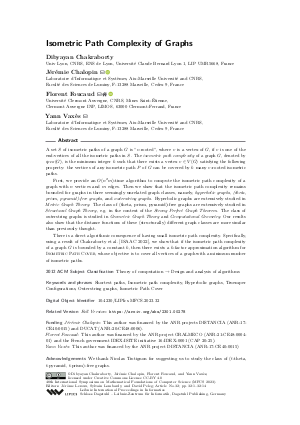@InProceedings{chakraborty_et_al:LIPIcs.MFCS.2023.32,
author = {Chakraborty, Dibyayan and Chalopin, J\'{e}r\'{e}mie and Foucaud, Florent and Vax\`{e}s, Yann},
title = {{Isometric Path Complexity of Graphs}},
booktitle = {48th International Symposium on Mathematical Foundations of Computer Science (MFCS 2023)},
pages = {32:1--32:14},
series = {Leibniz International Proceedings in Informatics (LIPIcs)},
ISBN = {978-3-95977-292-1},
ISSN = {1868-8969},
year = {2023},
volume = {272},
editor = {Leroux, J\'{e}r\^{o}me and Lombardy, Sylvain and Peleg, David},
publisher = {Schloss Dagstuhl -- Leibniz-Zentrum f{\"u}r Informatik},
address = {Dagstuhl, Germany},
URL = {https://drops.dagstuhl.de/entities/document/10.4230/LIPIcs.MFCS.2023.32},
URN = {urn:nbn:de:0030-drops-185666},
doi = {10.4230/LIPIcs.MFCS.2023.32},
annote = {Keywords: Shortest paths, Isometric path complexity, Hyperbolic graphs, Truemper Configurations, Outerstring graphs, Isometric Path Cover}
}

 Creative Commons Attribution 4.0 International license
Creative Commons Attribution 4.0 International license




























